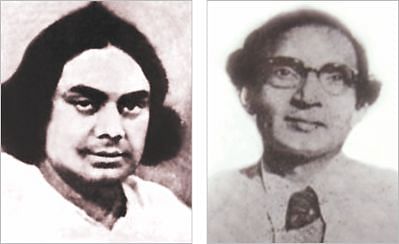The unparalleled duo Nazrul-Abbasuddin

Eid-ul-Fitr is never complete for the Bangali Muslims without Kazi Nazrul Islam's wonderful song O mon Ramjaner oi rojar sheshey elo khushir Eid. The appropriate lyrics and the sweet jovial tune of the song absolutely fit the merriment of the occasion. The importance of the song is that it was the first Islamic song of Nazrul to be recorded on LP. And the singer whose brilliant voice turned the song into a phenomenon was Abbasuddin Ahmed.
“One day my father went to Nazrul Islam,” says Ferdousi Rahman, daughter of Abbasuddin Ahmed and renowned artiste of Nazrul Sangeet and Bhawaiya songs, “and told him if Islamic songs could be recorded in Bangla in the manner of Urdu Kawalis, which were extremely popular at that time.” Abbasuddin pointed out that such Islamic songs would make Nazrul popular to the Bangali Muslims to whom he was like a heretic. “At that time, Muslims considered music as unholy,” explains Ferdousi.
Considering Abbasuddin's proposal, Nazrul asked him to talk to Bhagabati Bhattacharya, the rehearsal-in-charge of the Gramophone Company. “At first, Bhagabati Babu became very angry about the idea,” writes Abbasuddin in his autobiography, Amar Shilpi Jiboner Kotha; for, Bhagabati thought it wouldn't be accepted by the music lovers.
However, after six months, at a favoured moment, Abbas once again mentioned the proposal, and “this time the old man nodded 'yes',” says Ferdousi as she heard from her father. “After the recording, Abba [father] went home for Eid-ul-Fitr. On his way back to Kolkata, he heard several times that people were humming the song.” Abbasuddin wondered how these people learnt about the song at all! In Kolkata, Abbasuddin found an overwhelming situation; the LP, which also contained another song--Islamer oi shawda loye, sold thousands of copies. Abbasuddin Ahmed and Kazi Nazrul Islam became an unparalleled duo.
The song O mon Ramjaner oi rojar sheshey is further important because it drew the then Bangali Muslim community towards music which they considered profane. “Nazrul and my father enhanced this improvement more by songs like Allah amar probhu; Elo abar Eid phirey; Khodar premer shorab piye; Tribhubaner priyo Mohammad; Shono shono ya Elahi; Allah naamer bij bunechhi; Allah-ke je paitey chaay and many other popular songs,” says Ferdousi.
“Once Abba was invited by the students of Joypurhat but he was requested not to use harmonium as people considered it irreligious,” says Ferdousi. “Abba came on stage and told the audience that he was going to talk only rather than sing. Then he described how the whole world rejoiced Prophet Mohammad's (SM) birth, and started to sing, without any instrument of course, Nazrul's famous song Tora dekhe ja Amina mayer koley.” After singing another song, Abbasuddin wanted to leave the stage, but the audience was won over by that time. Then he improvised a little music by using tabla and sang another religious song, Amar Mohammader naamer dhyan hridoye jar roy. “Thus Abba helped music gain acceptance to the Bangali Muslims,” added Ferdousi.
She tells the story of another famous song, Hey namaji amar ghorey. “One day while waiting at Nazrul's place, Abba wanted to say his prayer. Nazrul Islam became very concerned, as there was no jainamaz [prayer mat] in the house. He finally gave Abba a clean shawl to use as jainamaz. After his prayer, Abba found that Nazrul Islam had meanwhile written the beautiful song.” The song offers to the pious the heart of the poet as a prayer mat.
Another important aspect of Nazrul-Abbassuddin combination was that through their songs they helped retain the peaceful co-habitation of the Hindus and the Muslims when communal riot broke out in the region. “Together abba and Nazrul produced anti-communal songs like Bharater dui nayon tara Hindu Musalman, Hindu ar Muslim mora dui shahodar bhai and O bhai Hindu Musolman,” says Ferdousi.
“Abba also sang many of Nazrul's folk songs and these instantly became widely popular, especially with the urban audience who didn't have much access into the realm of Bangla folk music. Nazrul also liked his voice and style of rendering Bhawaiya songs. So, he wrote songs like Nodir naam shoi Anjana/Nachey teerey Khanjana; Padmodighir dharey dharey--Nazrul's first folk songs to be recorded,” informs Ferdousi.
Abbasuddin recorded hundreds of Nazrul's songs, which enjoyed tremendous popularity at that time and still are. His first record of “Adhunik” Bangla song, Laili tomar eshechhey phiriya has become an icon of modern Bangla songs.

 For all latest news, follow The Daily Star's Google News channel.
For all latest news, follow The Daily Star's Google News channel. 



Comments